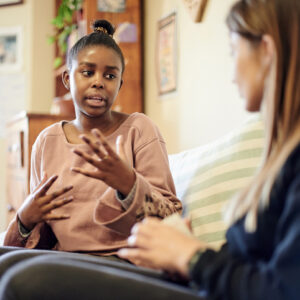Feeling SAD? How to Combat Seasonal Affective Disorder

As the seasons change and the weather grows chillier, our bodies and lifestyles also need to adjust. While some enjoy this time of year as an opportunity to cozy up under a blanket with a cup of hot cocoa, others find these darker months more difficult to get through.
If you or a loved one are struggling with mental health around this time of year, it could be more than just the winter blues. At KVC West Virginia, we know how challenging seasonal affective disorder (SAD) can be for both adults and children. Keep reading to explore the different symptoms and treatments of this common mental health condition and learn how to be more proactive with yourself or a loved one.
What is Seasonal Affective Disorder?
Seasonal affective disorder (SAD) is a mental health condition characterized by the onset of depressive symptoms during specific times of the year. SAD often coincides with the reduced sunlight and time outside, giving this mood disorder the misnomer of “the Winter Blues” in the past. As our knowledge and awareness of mental health have grown and evolved, it is clear that SAD is more than a seasonal fluke.
“Seasonal affective disorder is not just a form of ‘the blues,’” explains Erin Keltner, Vice President of Clinical Services at KVC West Virginia. “It’s actually a form of depression.”
Seasonal affective disorder checks the same symptom boxes as many other types of depression, including:
- Feeling down or despondent most of the day
- Losing interest in activities that usually bring joy
- Difficulty sleeping or sleeping too much
- Eating more than usual and gaining weight, or eating less than usual and losing weight
What makes seasonal affective disorder so unique is that the depression symptoms relate to the weather and the changing of the seasons, as opposed to the other forms of depression which can show up at any time and last year-round. As Keltner explains, “Where we might see normal depression affect someone some of the time or most of the time throughout the year, those that struggle with seasonal affective disorder typically only experience symptoms during the fall or winter.”
While SAD is most common in the colder months, a small percentage of people experience this depressive effect in the spring and summer instead. In these cases, symptoms tend to include insomnia, anxiety and irritability. Because sunlight and warmth are believed to have increased benefits for our health and wellbeing, this form of SAD is much less common.
What Causes Seasonal Affective Disorder?
While the specific causes of SAD are still unclear, research suggests that several key factors contribute to this experience, like the balance of our circadian rhythms and hormone levels (i.e., serotonin and melatonin). Changes in the amount of sunlight may disrupt your biological clock and reduce the amount of serotonin and melatonin needed to keep your mind and body balanced. This may result in the onset of seasonal affective disorder.
How to Treat Symptoms of Seasonal Affective Disorder
For those who find themselves struggling with depressive symptoms that may stem from SAD, here are some treatment options that can help:
Therapy
Therapy can help you or a loved one talk through challenges and learn how to cope with and manage the symptoms of SAD. KVC offers mental health screenings that can be used to assist in treatment and help you connect with a therapist. Contact your local KVC office to learn more about our therapy services.
Medication
There are various prescription medications available to ease the symptoms of SAD, although this treatment method can get more complex the medication is not required year-round. Contact a physician or other trusted medical professional to help you determine if this is the right path for you or your loved one.
Light Therapy
 Also called phototherapy, light therapy uses naturalistic light to help compensate for the lack of sunlight, balancing serotonin activation and helping to align your circadian rhythms. It’s especially helpful for those who suffer from symptoms during the autumn and winter.
Also called phototherapy, light therapy uses naturalistic light to help compensate for the lack of sunlight, balancing serotonin activation and helping to align your circadian rhythms. It’s especially helpful for those who suffer from symptoms during the autumn and winter.
According to the National Institute of Mental Health (NIMH), a person sits in front of a very bright light box (10,000 lux) every day for about 30−45 minutes, usually first thing in the morning, from fall to spring. This light box is approximately 20 times brighter than normal indoor light and filters out potentially damaging UV light. It’s a safe treatment for most people, but people with certain eye diseases or taking certain medications may need to use alternative treatments or talk to their doctor before starting light therapy.
Supplement with Vitamin D
Studies show that vitamin D can help reduce or even prevent symptoms of seasonal affective disorder since sufferers are usually vitamin D deficient. We naturally absorb vitamin D from the sun, so it makes sense that decreased sunlight means a drop in this essential mood-boosting vitamin! Please talk to your doctor before taking an additional supplement.
How to Help Children with Seasonal Affective Disorder
 Similar to adults, children and teens can also be affected by the change of seasons on a deeper level. Although mood disorders like seasonal affective disorder more commonly develop during adulthood, these symptoms can show up at any age. These symptoms may also look different in children and teens than they do in adults. Parents and caregivers who suspect a child in their care may be struggling with SAD can take the following steps to help:
Similar to adults, children and teens can also be affected by the change of seasons on a deeper level. Although mood disorders like seasonal affective disorder more commonly develop during adulthood, these symptoms can show up at any age. These symptoms may also look different in children and teens than they do in adults. Parents and caregivers who suspect a child in their care may be struggling with SAD can take the following steps to help:
Stay Observant
Keep an eye out for clues that a child is struggling with seasonal affective disorder, paying special attention to patterns with symptoms and when they start. Especially if the symptoms have appeared at the onset of winter, and no other major life changes have occurred, seasonal affective disorder may be likely. Symptoms can include:
- Irritability
- Changes in sleep patterns
- Eating more or less than usual
- Becoming increasingly lethargic
- Self-isolating
Keep Communication Open and Safe
Children and teens thrive when communication with their caregiver is calm and in a trustworthy environment. You can care for your child by remaining a safe space for them to learn, heal, rest and grow, even when it’s tough. Find tips on how to talk to children and teens about mental health in this article.
Encourage Outdoor Activities and Exercise
 Although it may be necessary to bundle up, fresh air and sunshine can help to reduce SAD symptoms. Exercise is also proven to help feelings of depression and boost our moods, whether performed indoors or outside. Even a quick walk around the block can make a difference!
Although it may be necessary to bundle up, fresh air and sunshine can help to reduce SAD symptoms. Exercise is also proven to help feelings of depression and boost our moods, whether performed indoors or outside. Even a quick walk around the block can make a difference!
Get Professional Help and Support
Counselors, therapists, doctors and mental health organizations like KVC are here to help! Children don’t have to go through this alone, and neither do their parents and caregivers. Contact your local KVC office to learn more about our mental health therapy services.
If depression symptoms worsen or become severe, or the child is thinking or talking about suicide, seek immediate support. The 988 Suicide and Crisis Lifeline is available to help 24/7. Find more information on their website or call 988 to reach a professional. If there is an emergency that requires immediate medical attention, call 911.
How to Manage Symptoms of SAD in Everyday Life
Once it’s clear that someone struggles with seasonal affective disorder, symptoms can be proactively managed to improve daily life. Seeking professional treatment or prescription medication year-round can help you or your loved one stay ahead of the curve.
 Another necessity is finding self-care activities and coping skills to stay on top of SAD symptoms. “Have those coping skills ready for when September and October hit,” Keltner advises. “Think ahead: what tools work best for an individual to combat this? And what enjoyable activities are available to keep our minds away from focusing on the dark and cold weather?”
Another necessity is finding self-care activities and coping skills to stay on top of SAD symptoms. “Have those coping skills ready for when September and October hit,” Keltner advises. “Think ahead: what tools work best for an individual to combat this? And what enjoyable activities are available to keep our minds away from focusing on the dark and cold weather?”
There are numerous options to proactively prepare for this time of year and any symptoms that may arise. Here are some ideas that can help:
- Open the shutters or blinds to let more natural light indoors and spend some time reading or relaxing next to the window
- Take a 20-30 minute walk outside each day, especially when the weather is nice
- Take advantage of natural remedies like vitamin supplements and light therapy lamps
- Establish a set routine before the season begins and keep to it
- Prioritize socializing and hobbies that bring you joy
- Plan fun events and activities throughout fall and winter to give yourself something to look forward to
Managing seasonal affective disorder is about doing your best to stay on top of the symptoms while also recognizing when it’s time to seek additional help. Some mild SAD symptoms can be managed independently, but major depression or anxiety requires treatment and support. If the symptoms of SAD in yourself or your loved one persist every day for at least two weeks and extend beyond just feeling down, you should seek professional support and treatment.
Look to KVC for Support and Treatment Options

“Seasonal affective disorder was once an unrecognized and overlooked condition that is now recognized and accepted as a mental health disorder, and it’s important for people to acknowledge that and get help,” Keltner says. Support for mental health conditions like seasonal affective disorder (SAD) is more readily available than ever before, and those who are suffering shouldn’t hesitate to seek out these helpful resources.
KVC offers a wide range of therapy and treatment options for children, adults and families in need. Through both individual and family therapy, KVC uses a unique Safe and Connected™ model that helps clients to develop constructive working relationships with KVC providers. Our dedicated and professional staff is ready to assist you and your loved ones with any mental health concerns, from recommendations for treatment to active and ongoing therapy services. Be proactive this year and contact KVC to help manage seasonal affective disorder — or to address any other mental health-related concern, from this season and beyond.

